Simple ways to propagate figs by cuttings at home
Countries with a subtropical climate are considered the birthplace of figs. Previously, in Russia, it was grown only in hot Krasnodar and the Crimea. Later, varieties were bred that are suitable for cultivation in regions with a temperate climate and, with proper care, can withstand temperatures down to -20 ° C.
There are several ways to propagate figs, but the most popular is cuttings. This method allows you to get a large amount of planting material, which quickly takes root and retains the maternal characteristics. How to propagate figs by cuttings at home, read on.
The content of the article
Is it possible to grow and propagate figs at home
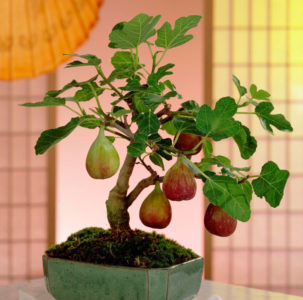
It is possible to grow figs at home. More and more gardeners are engaged in the cultivation of this plant on the windowsill, because the fig tree is undemanding to care for, and it is easy for it to create suitable conditions on the windowsill.
Fig tree Is a ficus. It has a beautiful branched crown with large cut leaves. It looks attractive even without flowers and fruits.
During flowering, the plant is covered with large flowers that look like a tea rose, but have a larger number of stamens. Bears fruit with beautiful and tasty dark purple fruits.
In order for the plant to bloom and bear fruit at home, it is important to choose the right variety. It is imperative to use self-fertile varieties (Solnechny, Sochi, Kadota), since it will be problematic to "force" the fruit to set a tree that requires pollination.
For a plant to bear fruit, it must be propagated vegetatively. The seeds often grow wild, which begins to bear fruit late or does not bloom at all.
Note! At home, figs reach a height of up to 1.5 m (depending on the size of the pot). An adult plant produces up to 100 fruits per year.
Features and benefits of propagating figs by cuttings
Most gardeners prefer to cut the fig tree. The advantages of this breeding method are obvious:
- Allows to obtain a large amount of planting material Branches obtained by pruning a plant are often used. This is the advantage of the method over layering.
- Cutting allows you to achieve the first flowering faster than propagating by seeds.
- When propagated by the vegetative method, the fig tree retains varietal characteristics.
- Fig cuttings root well and quickly. They are easy to work with.
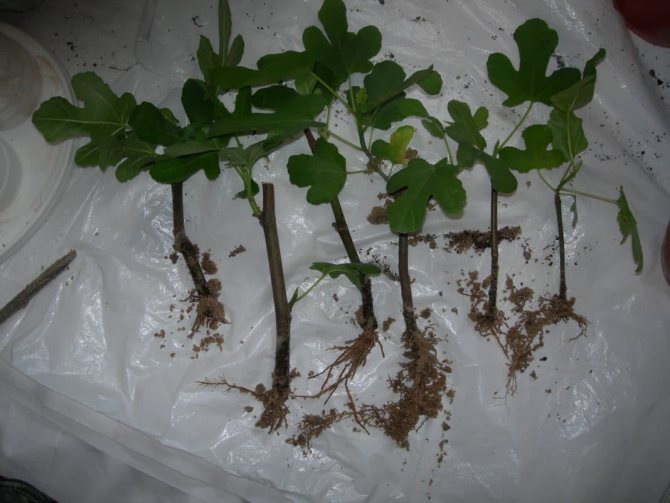
Suitable dates
For the cuttings to take root quickly and easily, it is important to choose the right timing for harvesting and planting. Possible options:
- Spring. It is best to cut green cuttings in the spring, before the buds wake up. It is better to do this in early March. Slicing is also possible at the end of February. Such planting material is ready for rooting immediately after pruning, that is, in the spring.
- Fall. In the autumn, lignified cuttings are harvested. They are rooted only next spring.
- Summer. Figs can also be propagated in summer. This time is suitable for two ways of cuttings. However, many gardeners believe that in the summer, the branches root less and the plant experiences more stress when pruning. It is also important that the sun is not active when cutting. The procedure is carried out in the morning or in the evening.
Cutting options
For growing figs, green and lignified planting material is used.Working with such cuttings has some differences. This should be taken into account when choosing a method.
In both cases, it is important to choose a suitable mother plant. It should already bloom and bear fruit. This is a guarantee that daughter trees will also have this ability.
It is important to inspect the tree for disease and pest damage. If there are any suspicious spots and other symptoms, reproduction is tolerated until the plant is completely cured.
Lignified cuttings
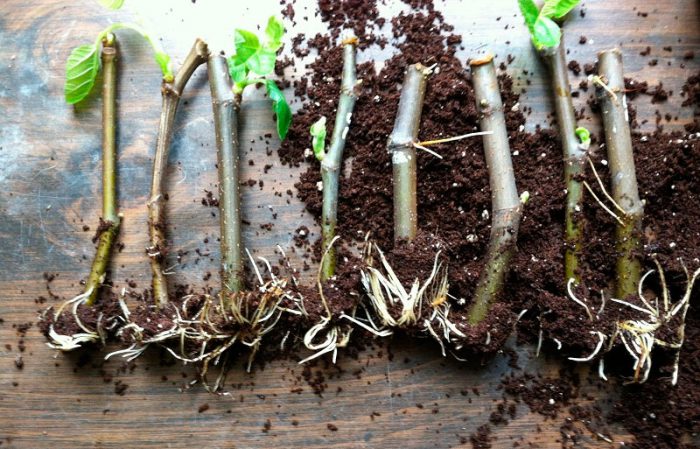
Lignified cuttings have a hard but elastic bark. If you make a cut in it, you can see the green layer. The branches should not be too old or dry. It is important that there is no damage, signs of damage from diseases and pests.
The branches are cut into lengths from 15 to 25 cm. They must have at least three live buds. The lower cut is made at an angle of 45 °, and the upper cut is perpendicular to the branch.
The collected branches are placed in storage. If there is a basement, they are buried in sand boxes. Before use, the sand is disinfected with a hot dark pink solution of potassium permanganate or by calcining in the oven (30-40 minutes at 180 ° C).
In the basement, planting material is stored at a temperature of + 1 ... + 5 ° C. Once every 30 days, the sand is moistened with a small amount of cold water so that the cuttings do not dry out.
Council. If there is no basement, planting material is stored in the refrigerator, previously wrapped in a damp cloth.
In March, the cuttings are cleaned of sand. The lower part is shortened by 1.5-2 cm. On the bark (in the lower part), cuts are made 1.5 cm deep. The depth of such notches should be such that the green epithelium is not damaged.
Note! Lignified cuttings take root within 45-60 days.
Green cuttings
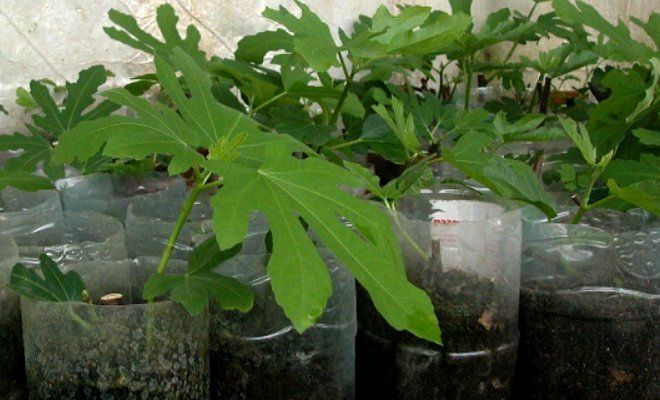
Green cuttings are cut in the spring. They must be absolutely healthy, well developed, without damage. The number of buds on quality pruning is at least 3-4. The branches are cut at a 45 ° angle.
From a cut of green branches, juice is released, resembling milk. Immediately after cutting, the planting material is left for 6-8 hours to stop sap flow.
For 4-6 hours, the planting material is kept in a cool, dark place. Shallow notches are made on the bark. After that, the cutting is immediately rooted. The workpieces form a root system in 1.5-2 months.
Note! Notches on the bark are made so that the root system is formed faster and is more developed.
Preparing cuttings
Both lignified and green cuttings are prepared for planting. This process involves three stages:
- Disinfection. The cuttings are soaked for an hour in a light pink solution of potassium permanganate. It is not necessary to lower the entire branch into the liquid; it is enough to pay attention to the cuts.
- Growth stimulation. For this, the planting material is soaked in a solution of a growth stimulant, for example, "Kornevin" or "Heteroauxin". For green branches, the duration of soaking is 30-40 minutes, and for lignified branches - 1.5-2 hours.
- Slicing processing. To do this, the upper and lower sections are dipped in ash or tobacco dust.
Immediately after processing, the planting material is ready for rooting. The procedures described are carried out on the day of planting.
Rooting twigs
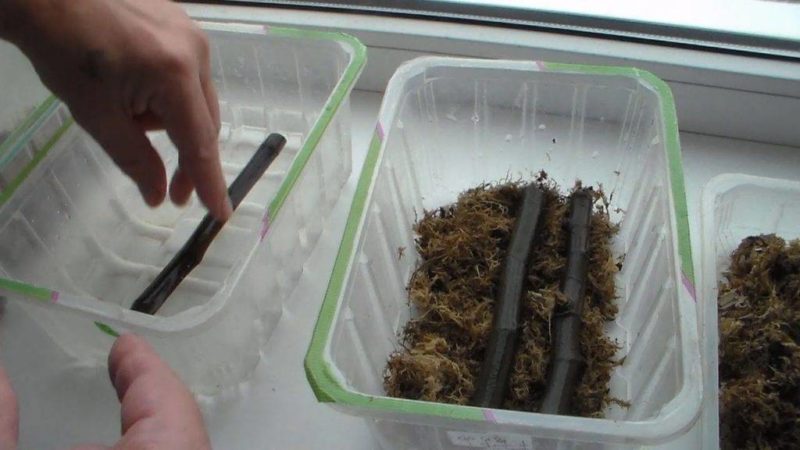
There are several ways to root fig cuttings. Possible options are presented in the list:
- Sand. Before rooting the figs from the twig, the sand is disinfected with a dark pink solution of potassium permanganate, boiling water, or in the oven. The substrate is poured into a plastic cup. The stalk is buried in the sand by 3 cm. A bag or a cut bottle is put on the container and twig. Every day, the greenhouse is disassembled and the planting is aired for 15 minutes. As it dries, the sand is moistened with warm water, and the cutting is also moistened. The greenhouse is dismantled only after the branch has taken root.
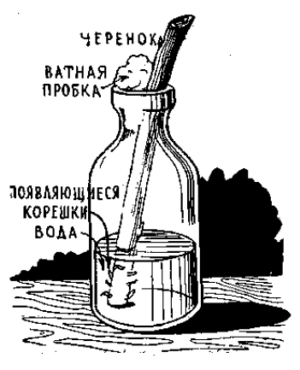
- Water. Warm water is poured into a jar or plastic glass to a height of 3 cm. Another option is to put cotton wool dipped in liquid into the glass. Add liquid as it evaporates.To speed up the process of root formation, a growth stimulant is added to the water.
- Nutrient soil. To prepare a soil suitable for rooting, mix 2 parts of garden soil and humus, 1 part of sand and 1 part of peat. The soil mixture is calcined in the oven or watered with a dark pink solution of potassium permanganate. 3-5 cm of drainage is poured onto the bottom of the container (fine gravel, expanded clay, broken brick, chipped ceramics), the rest of the volume is filled with soil. The stalk is buried 3 cm. The soil around it is compacted. A layer of sand is poured on top. A bag or a cut bottle is put on the handle. The greenhouse is ventilated daily for 15 minutes. As it dries, the soil is moistened with warm settled water.
When placed in sand or water, the cutting is transplanted into a new container with soil as soon as it takes root. If the branch was immediately planted in the ground, it is transplanted only when the root system fills the entire pot.
The fact that the branch has taken root is indicated by the awakened buds. The plant will start throwing out leaves or new shoots.
If you plan to plant a tree in open ground, the seedling is grown in a greenhouse or at home throughout the year. By the time of transplantation to a permanent place, the root system should be well-formed, and the tree should be strong. In this case, as the pot is filled with roots, the plant is transplanted into a new container, larger in size.
Landing
Planting a grown seedling depends on where the fig will grow. If it is used as a houseplant, it will have to be transplanted into pots of different diameters several times.
When grown outdoors, one- and two-year-old seedlings are used. By the time of planting in a permanent place, they should have a formed root system and several branches.
In pots
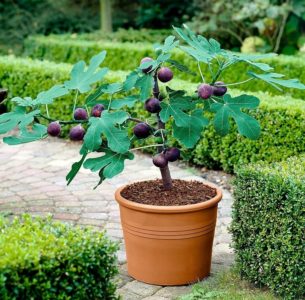 If the cuttings have been placed in water or sand, they are transplanted into a pot as soon as they take root. If a nutrient soil mixture was used, transplanting is carried out after the root system of the figs completely fills the old container.
If the cuttings have been placed in water or sand, they are transplanted into a pot as soon as they take root. If a nutrient soil mixture was used, transplanting is carried out after the root system of the figs completely fills the old container.
A home transplant is carried out several times as the pot fills with the root system. Usually, adult figs are grown at home in a 6-8 liter pot.
How to plant figs in a pot:
- A 5 cm thick drainage layer and a little soil are poured onto the bottom of the disinfected container.
- Figs are taken out of the pot along with a lump of earth. Scrape off the layer with old drainage.
- The plant is transferred to a new container. The free space is covered with soil mixture.
- Figs are poured over with warm settled water.
In open ground
There are two ways to plant fig seedlings outdoors. In the first case, the plants are planted in trenches, in the second - in holes. Planting technology has differences.

Correct trench landing technique:
- Dig a trench up to 1 m deep. The wall of the trench, located on the north side, should have a slope of 90-85º, and the south wall should be at a slope of no more than 30º. This is necessary for the soil to warm up better.
- At the bottom of the trench, holes are dug 40-60 cm deep at a distance of 1 m from each other. The soil removed from them is mixed with 2 kg of rotted manure, 30 g of superphosphate, 20 g of potassium sulfate, 1 tbsp. ash and 5 kg of sand.
- 5 cm of drainage is poured at the bottom of the hole (you can use broken brick or expanded clay, but not concrete). Then part of the soil is covered. A seedling taken out of a pot is placed in the hole along with an earthen lump.
- The hole is covered with soil. The soil around the seedling is compacted and watered with plenty of warm water. The trunk circle is covered with a layer of mulch, for example, peat or rotted straw.
- Trench walls reinforce a mixture of clay and chipped bricks.
They also use pits. In this case, there are other features:
- Dig a hole 50 cm in diameter and 80 cm deep. The soil removed from the hole is mixed with 8 kg of manure and 200 g of "Nitroammofoski".
- 5-10 cm of drainage is poured at the bottom of the hole... Lay out 15 cm of nutrient mixture on top.
- A seedling is placed in the hole together with a lump of earth. The pit is covered with soil, which is compacted.
- The tree is watered... The soil around it is mulched.
Care after landing
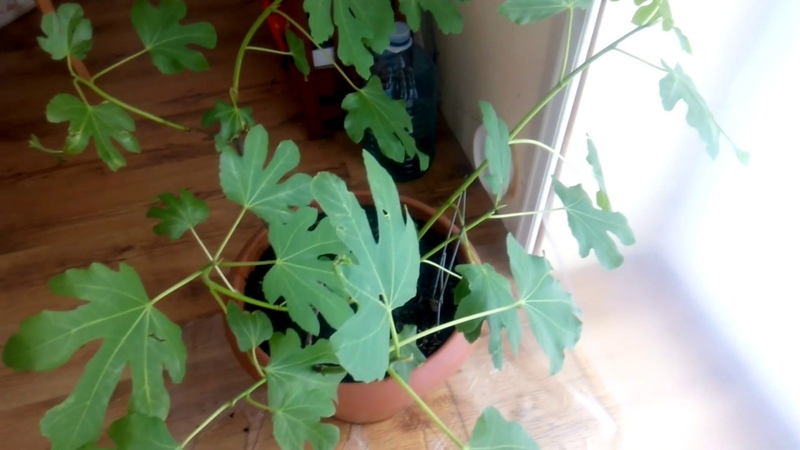
In the first year after planting, caring for figs in the garden will be minimal:
- Watering. In hot dry weather, the tree is watered daily, spending at least a bucket of water per plant. In cool and humid weather, the amount of watering is reduced to twice a week.
- Loosening. After each watering and precipitation, the soil is loosened. In the process of loosening, weeds are removed, which are considered one of the causes of infection of plants with diseases and pests.
- Top dressing. They are held every two weeks. Use a solution of chicken manure, manure or ammonium nitrate.
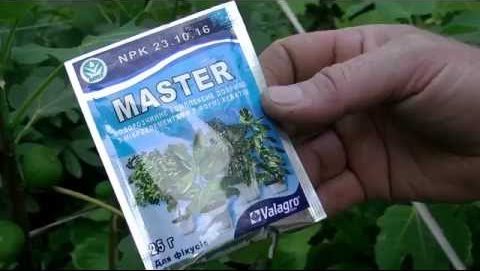
- Protection from disease. To prevent infection of figs with diseases, in spring and autumn it is sprayed with a solution prepared from 1 bucket of water and 1 tbsp. l. copper sulfate.
- Preparing for the winter. All fallen leaves are removed in autumn. The tree is bent to the ground, covered with foil, sprinkled with earth, and then branches and leaves. If possible, in winter, the structure is covered with snow.
It is not necessary to form a plant in the first year of growing.
Conclusion
Figs are usually propagated by cuttings. After all, it is this method that allows you to get a large amount of planting material literally from the scraps remaining during formation. They take root quickly, develop well and retain the varietal characteristics of the parent plant.
Figs are bred by cuttings for growing in the garden and at home. The rooting process is simple to perform, even a novice gardener can handle it.
"During flowering, the plant is covered with large flowers, which outwardly resemble a tea rose" (C) Congratulations to you lies!
I was born 70 (seventy) years ago and have lived in Sochi all my life! In all my life I have never seen such flowers on figs! I will not even prove anything and describe the reproduction of this plant. I’ll just quote the classics: "Who once lied, who will believe you?" (C) Kozma Prutkov